To explore earthy herbal tea flavors, start with root herbs like ginger and dandelion. Embrace mushroom-infused blends, such as reishi and chaga, for unique tastes and health benefits. Experiment with barks and woods, including cinnamon and cedar, to add depth. Incorporate mineral-rich herbs like nettle and horsetail for subtle earthy notes. Try roasted varieties, such as dandelion root or barley tea, for nutty undertones. Pair your teas with complementary spices to enhance their profiles. Finally, steep your blends longer to extract deeper, more robust flavors. These tips will set you on a journey to discover a world of rich, complex tastes.
Start With Root Herbs
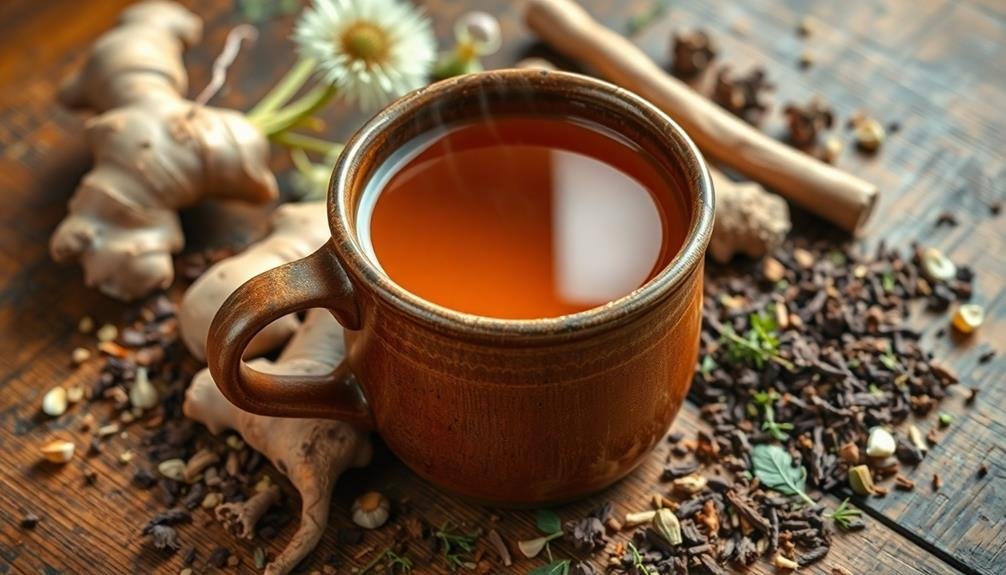
Many herbal tea enthusiasts begin their flavor journey with root herbs. These earthy ingredients offer a robust foundation for exploring diverse tea flavors. You'll find that roots like ginger, turmeric, and dandelion provide distinct tastes and potential health benefits.
Start by trying ginger root tea. It's known for its spicy, warming qualities and can help soothe digestive discomfort. Steep fresh ginger slices or dried pieces for a zesty brew.
Next, explore turmeric root. Its vibrant yellow color and slightly bitter taste make for an intriguing cup. Turmeric is often praised for its anti-inflammatory properties.
Don't overlook dandelion root. This common weed yields a tea with a rich, coffee-like flavor. It's believed to support liver health and act as a natural diuretic.
For a milder option, consider burdock root. Its earthy, slightly sweet taste pairs well with other herbs.
When brewing root teas, you'll typically need to simmer them longer than leaf-based herbs. This extra time allows the flavors and beneficial compounds to fully extract.
Experiment with steeping times and temperatures to find your perfect brew.
Embrace Mushroom-Infused Blends
Mushroom-infused teas offer a range of health benefits, from boosting immunity to improving cognitive function.
You'll find popular varieties like reishi, chaga, and lion's mane teas gaining traction in the herbal tea world.
To brew these unique blends, you'll want to simmer the mushrooms longer than traditional teas to extract their rich, umami flavors and beneficial compounds.
Health Benefits of Mushrooms
While traditional herbal teas have long been celebrated for their health benefits, mushroom-infused blends are now taking center stage in the wellness world.
These powerful fungi offer a range of potential health advantages that you can easily incorporate into your daily routine through tea.
Reishi mushrooms, often called the "mushroom of immortality," may boost your immune system and help manage stress.
Chaga, rich in antioxidants, could support your body's defense against oxidative damage.
Lion's mane is believed to enhance cognitive function and promote mental clarity, making it an excellent choice for your morning cup.
Cordyceps mushrooms might improve your athletic performance and endurance, while turkey tail is known for its potential to support gut health and digestion.
Shiitake mushrooms are packed with vitamins and minerals that can contribute to your overall well-being.
Popular Mushroom Tea Varieties
Immerse yourself in the world of mushroom-infused teas with these popular varieties that have gained a devoted following.
Reishi mushroom tea stands out for its earthy flavor and potential immune-boosting properties. You'll find it often blended with other herbs to balance its bitter notes.
Chaga tea, known for its smooth, vanilla-like taste, is rich in antioxidants and has become a favorite among health enthusiasts.
For a milder option, try Lion's Mane tea. It's prized for its delicate flavor and potential cognitive benefits.
Cordyceps tea offers a nutty, slightly sweet taste and is popular among athletes for its purported energy-enhancing effects.
If you're looking for a unique flavor profile, consider Turkey Tail tea, which has a subtle earthiness and is often combined with fruity or floral notes.
Don't overlook Shiitake mushroom tea, which provides a savory umami taste and is frequently used in broths and soups.
Finally, Maitake tea offers a rich, woodsy flavor and is often sought after for its potential to support overall wellness.
Experiment with these varieties to find the mushroom tea that best suits your palate and health goals.
Brewing Techniques for Umami
To release the full umami potential of mushroom-infused teas, mastering the right brewing techniques is essential. Start by using filtered water heated to 175-185°F (79-85°C) for most mushroom teas. This temperature range helps extract the savory compounds without oversteeping.
When steeping, use about 1-2 teaspoons of dried mushroom tea per cup of water. Allow the tea to steep for 3-5 minutes, depending on your desired strength. For a more intense umami flavor, you can increase the steeping time slightly, but be careful not to over-extract, which can lead to bitterness.
Here's a quick reference guide for brewing different mushroom teas:
| Mushroom Type | Water Temp (°F) | Steep Time (min) | Tsp per Cup | Flavor Profile |
|---|---|---|---|---|
| Reishi | 175-185 | 3-5 | 1-2 | Earthy, bitter |
| Chaga | 175-185 | 5-7 | 1-2 | Mild, smooth |
| Lion's Mane | 175-185 | 3-4 | 1-2 | Delicate, sweet |
| Cordyceps | 175-185 | 3-5 | 1-2 | Nutty, earthy |
| Maitake | 175-185 | 4-6 | 1-2 | Rich, woodsy |
Experiment with blending different mushroom teas to create unique flavor profiles and enhance the umami experience. Don't be afraid to add complementary herbs or spices to balance the earthy notes and create a more complex taste.
Experiment With Barks and Woods
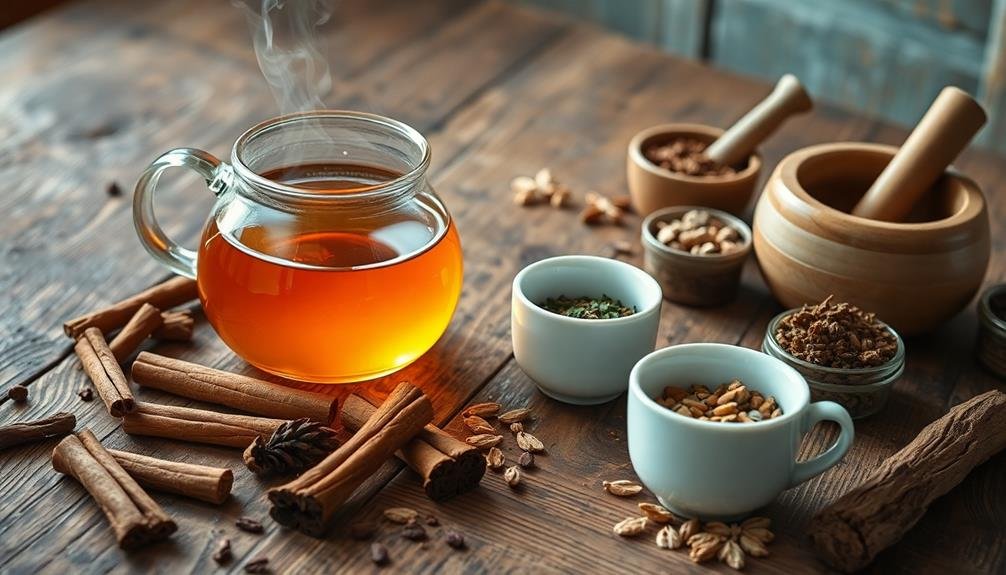
Exploration awaits as you venture into the world of barks and woods for herbal tea. These unique ingredients can add depth, complexity, and earthy notes to your brews.
Start with cinnamon bark, which offers a warm, spicy flavor and pairs well with apple or pear. Experiment with slippery elm bark for a subtle, slightly sweet taste that's also soothing for the throat.
Don't overlook the potential of woods like cedar or pine. Cedar imparts a distinct, aromatic quality reminiscent of forests, while pine needles can add a fresh, resinous flavor. For a smoky touch, try small amounts of mesquite or hickory wood chips.
Remember to use food-grade woods and avoid those treated with chemicals.
When incorporating barks and woods, start with small quantities and adjust to taste. Steep them separately from other herbs to gauge their individual flavors. You can also toast or lightly char some woods to enhance their taste profile.
Be mindful of steeping times, as over-extraction can lead to bitterness. As you explore these ingredients, you'll discover new dimensions in your herbal tea creations, elevating your brewing experience.
Incorporate Mineral-Rich Herbs
Moving beyond barks and woods, let's consider the nutritional aspect of herbal teas. Incorporating mineral-rich herbs can add both flavor and health benefits to your brews. You'll find that many of these herbs have distinct earthy tastes that complement other ingredients well.
Start with nettle, a nutrient powerhouse that's high in iron, calcium, and magnesium. Its green, slightly salty flavor pairs nicely with mint or lemon balm.
Horsetail is another mineral-rich option, offering silica and contributing a subtle, grassy taste to your tea. For a boost of potassium, try adding some dried alfalfa leaves.
Don't overlook seaweed in your herbal blends. Dulse and kelp are rich in iodine and add a unique umami flavor. They work well with ginger or citrus herbs.
Red clover is another excellent choice, providing calcium and magnesium while imparting a sweet, mild taste.
When using these mineral-rich herbs, remember that a little goes a long way. Start with small amounts and adjust to your taste preferences.
You'll soon discover how these nutritious additions can transform your herbal tea experience, creating complex flavors while potentially boosting your mineral intake.
Try Roasted and Toasted Varieties
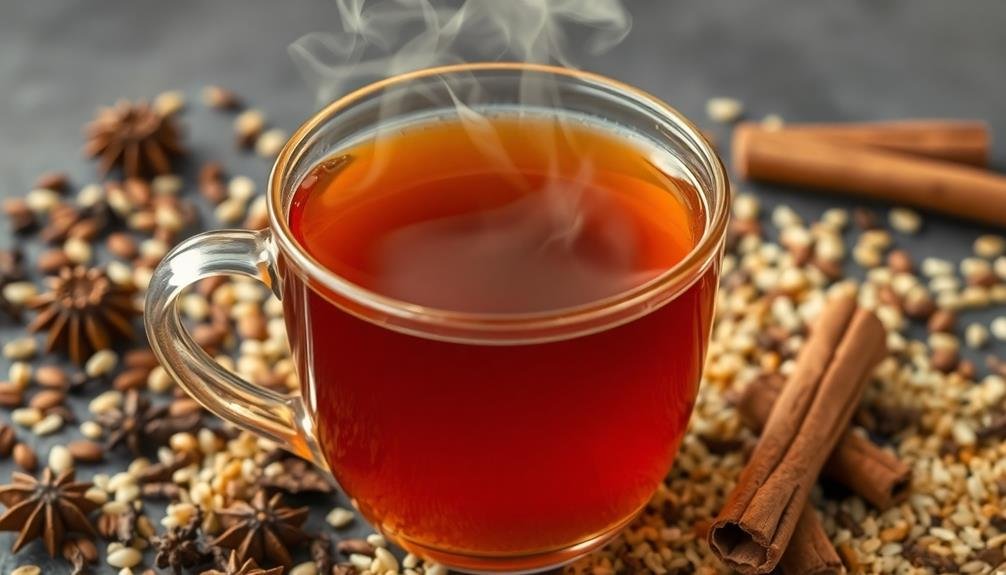
You'll discover new depth in your herbal teas by exploring roasted and toasted varieties.
The roasting process imparts nutty and caramelized flavor profiles, transforming familiar herbs into complex, rich infusions.
To enhance these robust flavors, try pairing roasted teas with complementary ingredients like cinnamon, vanilla, or even a splash of cream.
Depth Through Roasting Process
Roasting and toasting herbs can reveal a whole new dimension of flavor in your herbal teas. This process caramelizes natural sugars, breaks down fibers, and releases aromatic compounds, resulting in a richer, more complex taste profile.
You'll notice deeper, nuttier notes and a more satisfying mouthfeel in your brew.
To experiment with roasted herbs, try these techniques:
- Dry roasting: Heat herbs in a pan over medium heat, stirring constantly until fragrant.
- Oven roasting: Spread herbs on a baking sheet and roast at 350°F for 5-10 minutes.
- Tea roasting: Add herbs to your tea ball and heat over a flame until lightly toasted.
- Blending: Mix roasted and unroasted herbs for a balanced flavor.
Start with hardy herbs like dandelion root, chicory, or burdock for best results.
You'll find that roasted herbs pair exceptionally well with black teas and other full-bodied blends.
Don't be afraid to get creative – even delicate herbs like chamomile can benefit from a light toasting.
Nutty, Caramelized Flavor Profiles
Ever wondered how to achieve those rich, nutty flavors in your herbal teas? The secret lies in exploring roasted and toasted varieties. These preparation methods bring out complex, caramelized notes that'll transform your tea-drinking experience.
Try roasted dandelion root for a coffee-like flavor without the caffeine. It offers a deep, nutty taste with subtle bitter undertones.
Toasted rice tea, also known as genmaicha, combines green tea with roasted brown rice, creating a unique blend of grassy and nutty flavors.
For a sweeter profile, look for roasted chicory root. It develops a caramel-like taste when roasted, often used as a coffee substitute.
Roasted barley tea, or mugicha, provides a toasty, almost malty flavor that's invigorating both hot and cold.
Don't overlook roasted yerba mate, which offers a bold, smoky taste with hints of chocolate.
Experiment with blending these roasted herbs with other ingredients to create your own unique flavor combinations.
Complementary Ingredients for Richness
Enhancing the richness of your roasted herbal teas can be achieved by incorporating complementary ingredients.
Try experimenting with roasted and toasted varieties to add depth and complexity to your brew. These ingredients can transform a simple herbal infusion into a luxurious, full-bodied experience.
Consider adding these complementary ingredients to your earthy herbal teas:
- Toasted coconut flakes: They'll impart a nutty, tropical sweetness that pairs well with roasted herbs.
- Roasted cacao nibs: These will contribute a chocolatey undertone, enhancing the tea's richness.
- Toasted sesame seeds: They'll add a subtle, nutty flavor that complements earthy notes.
- Roasted dandelion root: This will introduce a coffee-like bitterness that deepens the overall flavor profile.
Don't be afraid to mix and match these ingredients to create your own unique blends.
Start with small amounts and adjust to your taste preferences. You'll find that these additions can elevate your herbal tea experience, creating a more satisfying and indulgent beverage.
Pair With Complementary Spices
Spices can transform your herbal tea experience, adding depth and complexity to your favorite brews. When pairing spices with herbal teas, consider the tea's base flavor and choose complementary spices that enhance its natural characteristics.
For earthy teas like rooibos or pu-erh, warm spices like cinnamon, cardamom, and ginger work well. Floral teas such as chamomile or lavender pair beautifully with delicate spices like vanilla or star anise. Citrusy herbs like lemongrass or lemon balm can be elevated with the addition of fresh ginger or a touch of black pepper.
Here's a quick guide to help you pair spices with different herbal tea bases:
| Tea Base | Complementary Spices | Flavor Profile |
|---|---|---|
| Rooibos | Cinnamon, Nutmeg | Warm, Cozy |
| Chamomile | Vanilla, Cardamom | Soothing, Sweet |
| Mint | Fennel, Licorice Root | Invigorating |
| Hibiscus | Clove, Allspice | Tart, Spicy |
Experiment with different combinations to find your perfect blend. Start with small amounts of spices and adjust to taste. You'll soon discover exciting new flavor profiles that elevate your herbal tea experience.
Steep Longer for Deeper Flavors
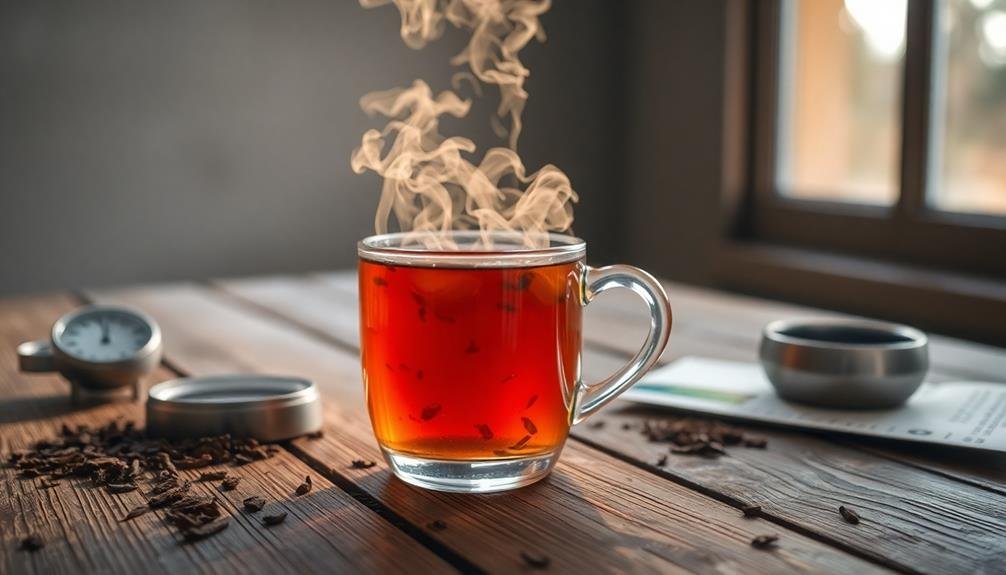
While spices can add complexity to your herbal tea, steeping time plays a key role in extracting maximum flavor. To reveal the full potential of earthy herbal teas, you'll want to experiment with longer steeping times. Most herbal teas benefit from a 5-10 minute steep, but for deeper, more robust flavors, try extending this to 15-20 minutes.
As you increase steeping time, keep these factors in mind:
- Water temperature: Maintain a consistent temperature throughout the extended steep. Use a tea cozy or insulated mug to prevent heat loss.
- Taste test: Sample your tea every few minutes to find your preferred flavor intensity. Some herbs can become bitter if steeped too long.
- Herb quality: Fresh or high-quality dried herbs will yield better results with longer steeps. Lower quality herbs may become unpleasant.
- Blend composition: Complex blends may require shorter steeping times to balance flavors, while single-herb teas often benefit from longer steeps.
Frequently Asked Questions
Are Earthy Herbal Teas Safe for Pregnant Women?
You should consult your healthcare provider before consuming any herbal teas during pregnancy. While some are safe, others can pose risks. It's best to err on the side of caution and get professional advice tailored to your situation.
Can Earthy Herbal Teas Help With Digestion Issues?
Yes, earthy herbal teas can help with digestion issues. You'll find that many, like ginger and peppermint, soothe your stomach and reduce bloating. They're naturally caffeine-free and can ease discomfort after meals. Try them for relief!
What's the Best Time of Day to Drink Earthy Herbal Teas?
You can enjoy earthy herbal teas at any time, but they're particularly soothing in the evening. They're caffeine-free, so you won't disrupt your sleep. Try them after meals to aid digestion or before bed for relaxation.
How Do Earthy Herbal Teas Compare to Green Tea in Caffeine Content?
You'll find most earthy herbal teas are naturally caffeine-free, unlike green tea which contains some caffeine. If you're looking to reduce your caffeine intake, herbal teas are a great alternative to green tea.
Are There Any Potential Side Effects of Drinking Earthy Herbal Teas Regularly?
While generally safe, drinking earthy herbal teas regularly might cause mild side effects. You could experience digestive issues, allergic reactions, or interactions with medications. It's best to consult your doctor if you're concerned about potential risks.
In Summary
You've now got the tools to immerse yourself in the world of earthy herbal teas. Don't be afraid to experiment and trust your taste buds. Mix and match different herbs, adjust steeping times, and play with temperatures to find your perfect brew. Remember, there's no right or wrong way to enjoy these teas. The journey of discovery is part of the fun. So grab your mug, steep some roots, barks, or mushrooms, and savor the earthy goodness.

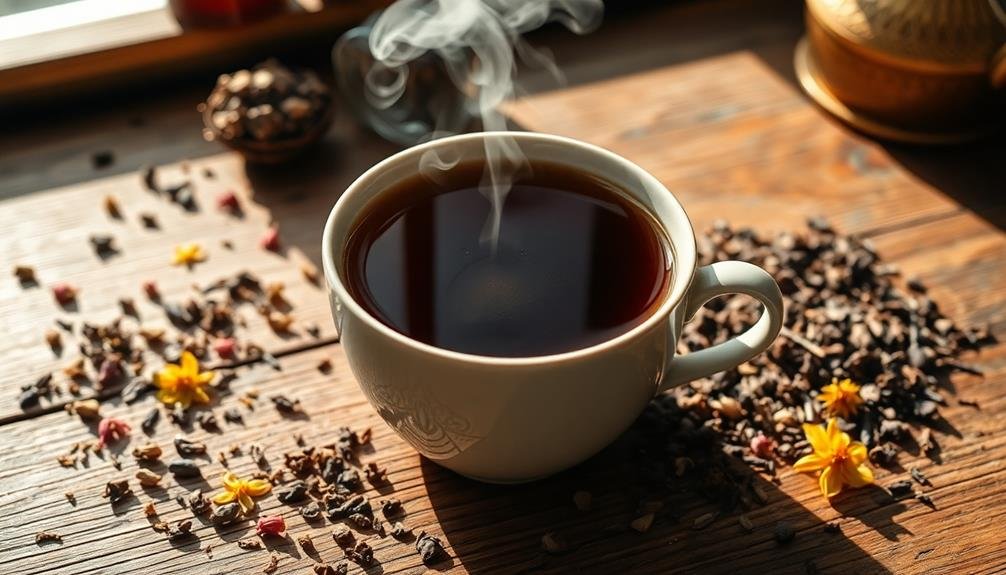



Leave a Reply